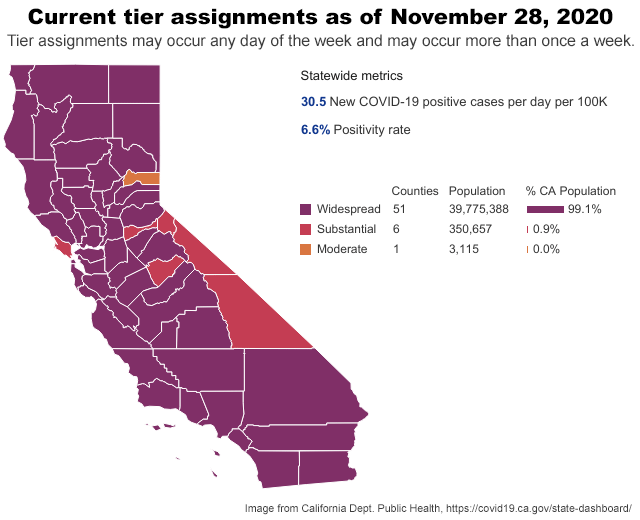Two weeks ago I wrote that California's long-running lockdown has been working. It's true; our average rates have been around half the US average, and we're among the top safest states in terms of low recent rates of infection. A big part of what's working about our lockdown is that it's evidence-based and adaptive. It's not all-or-nothing, arbitrary politics-driven like in many other states that are adopting restrictions for the first time in months or the first time ever— or, worse, are still refusing even to acknowledge basic reality. 😨
Coronavirus is surging nationwide, both in numbers of cases and numbers of deaths (links to my previous blogs). California is not immune from the upward trend. The worsening situation is reflected in California's COVID-19 tier assignments. Recall that as part of our data-driven, adaptive approach we've got a system of four risk tiers gauged by county and updated regularly. In the latest update another few counties regressed from Red to Purple, putting over 99% of the state's population at the strictest tier.

A number of lockdown policies are set by tier. For example, in Red restaurants can serve indoors at 25% capacity, provided they adhere to a list of safety requirements, while in Purple indoor dining is curtailed. Details can be found at California's Blueprint for a Safer Economy, if you're interested.
But wait, there's more!
A week ago California added a nighttime curfew (link to my blog on the topic) for places in Purple tier. And counties are able to add their own, additional restrictions. Within the past 24 hours my county, Santa Clara (population 2,000,000), announced a halt to live sports games, tighter restrictions on indoor retail, and a mandatory 14-day quarantine on people returning from travel.
Source: KPIX CBS News video
I point this out because it bothers me there are unenforceable laws. A plainly unenforceable law promotes cynicism against government and broadens the notion that obeying laws is optional. It's similar to what Enlightenment thinker Charles de Montesquieu wrote, "Useless laws weaken the necessary laws."
Coronavirus is surging nationwide, both in numbers of cases and numbers of deaths (links to my previous blogs). California is not immune from the upward trend. The worsening situation is reflected in California's COVID-19 tier assignments. Recall that as part of our data-driven, adaptive approach we've got a system of four risk tiers gauged by county and updated regularly. In the latest update another few counties regressed from Red to Purple, putting over 99% of the state's population at the strictest tier.

A number of lockdown policies are set by tier. For example, in Red restaurants can serve indoors at 25% capacity, provided they adhere to a list of safety requirements, while in Purple indoor dining is curtailed. Details can be found at California's Blueprint for a Safer Economy, if you're interested.
But wait, there's more!
A week ago California added a nighttime curfew (link to my blog on the topic) for places in Purple tier. And counties are able to add their own, additional restrictions. Within the past 24 hours my county, Santa Clara (population 2,000,000), announced a halt to live sports games, tighter restrictions on indoor retail, and a mandatory 14-day quarantine on people returning from travel.
Source: KPIX CBS News video
Useless Laws Weaken the Necessary Laws
The news piece ends with casting doubt on how the 14-day quarantine will be enforced. I agree, it's doubtful there will be any enforcement of that provision. There are neither policies nor mechanisms in place to do so, and creating them would be extremely difficult.I point this out because it bothers me there are unenforceable laws. A plainly unenforceable law promotes cynicism against government and broadens the notion that obeying laws is optional. It's similar to what Enlightenment thinker Charles de Montesquieu wrote, "Useless laws weaken the necessary laws."
no subject
Date: 2020-12-01 12:25 pm (UTC)If you were meant to be quarantining but weren’t at home when they checked, you had to provide a legitimate reason (eg seeking medical care) or were fined.
no subject
Date: 2020-12-01 04:58 pm (UTC)1) This quarantine is at the county level, where borders are very porous. Collecting information on who's arriving would require an enormous effort, setting up police checkpoints along numerous major highways and countless smaller roads as well. There is no budget at the county level for this kind of dragnet.
2) Such widespread checkpoints would set off alarm bells among civil libertarians-- and the anti-government wing of the Republican party. Recall that even a mask mandate in Michigan resulted in armed occupation of the state legislature in April. That act fits the literal definition of terrorism yet was blessed by Republican leaders nationwide and treated by police as a protected peaceful demonstration.
3) Followup tracing also runs afoul of both these issues. It's a big logistical undertaking for which there's much too little money. Modest tracing has already failed in this country due to too-little-too-late investment. And too many in the country would be up in arms (literally) at the fact that police are checking up on people just for traveling.